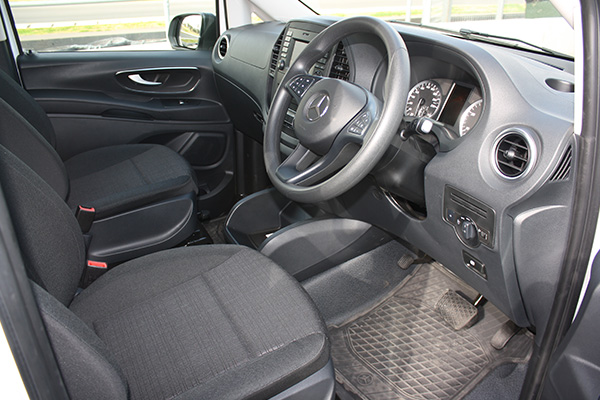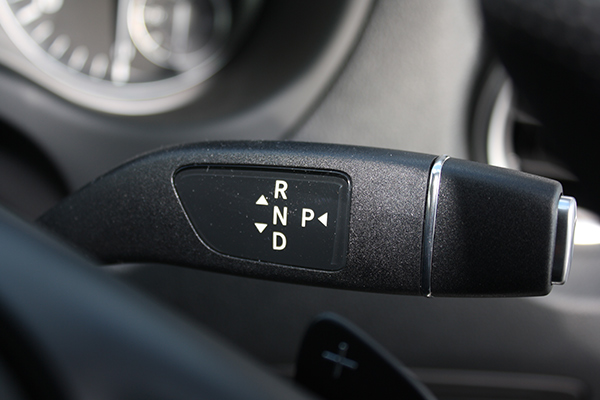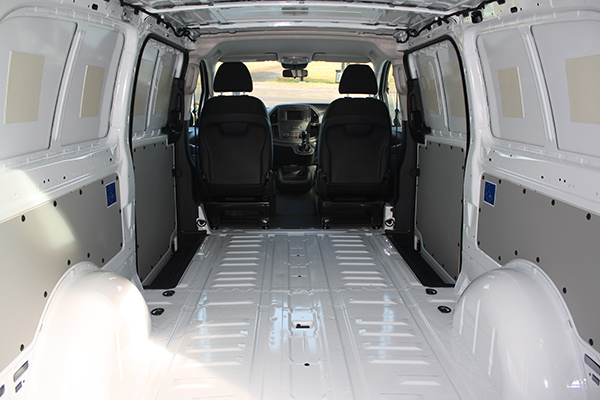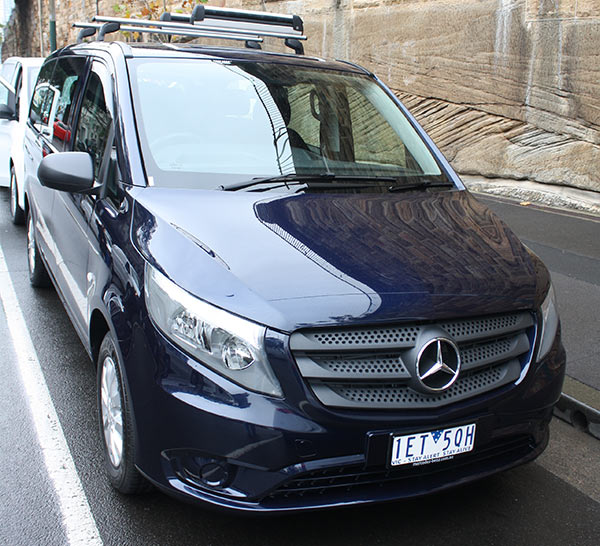An all new Mercedes-Benz Vito hit the Australian market this year and it was worth being at the launch to have a squiz
It was Douglas Adams, revered author of The Hitchhiker’s Guide to the Galaxy, who first coined the term ‘Zen navigation’.
The idea is if you are lacking direction or are lost you then try and find someone who appears to know where they are going and follow them.
After having a moment of techno rage with Mercedes-Benz’s satellite navigation, unit recently I decided to give Adams’ theory a shot.
As a native Victorian, I don’t have much of a grasp of Sydney’s CBD, but as I sat in the newly launched Vito that was trying to send me to Adelaide, I finally cracked the shits and decided to follow someone else who appeared to know where they were going.
Someone, who was also driving a new Benz Vito.
It wasn’t until I was committed that I realised my mistake.
The idea of saying “follow that van” wasn’t really a bright idea.
Following a white van in Sydney’s CBD at 9am on a weekday isn’t an easy task and within minutes the streets were filled with white vans, not all of them Mercedes Vitos, which were flitting here and there.
I may as well have said: “follow the bloke in a suit”.
Clearly this wasn’t a good plan.
It actually turns out the Vito doesn’t have a touchscreen.
This makes me look like a right goose as I sat there prodding and muttering obscenities at the screen for minutes on end before realizing that there is actually a joystick control for the multimedia unit.
Oops.
The Germans don’t really like touchscreens, which isn’t entirely unreasonable; a well-used touchscreen does tend to look a little icky after a while — especially if you add a little hamburger grease to your fingerprint profile.
Then it still wanted to send me to Adelaide.
I think the Mercedes-Benz crew waiting at Eastern Creek in Sydney’s west may have had a little issue with that somehow.
After following the wrong generic white van through the CBD for a couple of blocks, I finally worked out how to use the bloody machine and had a chance to be soothed by the dulcet robot tones of the Benz’s on-board brain.
Benz has widened the medium-sized Vito range and introduced a front-wheel drive entry level model as well as introducing a crew cab variant.
The all new platform represents an investment of €190 million (A$290 million)and clocked up 5.5 million kilometres of testing over the seven-year project, which, we are reliably told, is about 138 laps of the planet earth.
Managing director of Mercedes-Benz Vans Australia and New Zealand Diane Tarr says “there’s no compromise on quality or safety” with the new Benz.
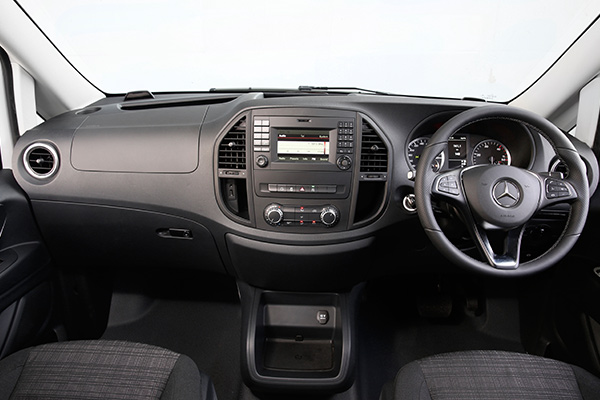
Engine
Two new engines power the van with a choice of either a Euro 5 level 1.6-litre turbo diesel or a Euro 6 2.2-litre BlueTEC turbo diesel.
The Euro 6 engine uses a selective catalytic reduction (SCR) system to clean up exhaust nasties and as such requires AdBlue to operate.
But Benz Australia is offering free AdBlue top-ups to Vito customers for the duration of the warranty period.
Torque is now claimed to be up by as much as 8 per cent while fuel efficiency is also claimed to have improved by 30 per cent.
The base 1.6-litre creates 84kW and 270Nm while the 2.2-litre BlueTEC donk is available in three power ratings, 100kW/330Nm, 120kW/380Nm and 140kW/440Nm.
Transmission
The Vito has a choice of a 6-speed manual tranny or a 7-speed torque converter auto.
The 7G-Tronic option gives the Vito a nice competitive advantage given the lack of a true auto option among its competitors.
The box itself owes its heritage to the S-Class passenger car range and is now also an option on Benz’s biggest van offering, the Sprinter.
The auto is the only transmission option available for 116 and 119 models.
Cab and Controls
When it comes to safety acronyms though, Benz is clearly ahead of the pack.
The Vito now uses a Bosch ESP9i electronic stability package which adds features such as cross wind assist, attention assist, ABS, ASR, BAS, EBD, ROM, LAC, RMI and USC.
There’s also a brake disc wipe to skim water off brake rotors if an impending emergency stop is detected as well as an electronic brake prefill that closes the distance between brake pad and rotor if the system detects the driver is going to stomp on the picks.
This is all meant to add valuable micro seconds to emergency response times.
There’s also the option to fill your Vito with all manner of bags of air that will deploy in case of an accident.
While Benz are clearly sending a message of safety, the bulk of these safety options are just that, options.
The base model short wheelbase 111CDI manual Vito is clearly aimed to snare the bread and butter buyer with a list price of $37,140 including GST.
But it doesn’t bring the same level of safety equipment as a couple of its competitors in the same price bracket.
The 111CDI is the first front-wheel drive Vito ever and uses the base 1.6-litre power plant.
While this does bring the three-pointed star within reach of a larger audience it does lag behind in terms of safety equipment without ticking any of the options boxes.
The ESP9i unit is standard across the range and brings with it features such as crosswind assist, load adaptive control, rollover mitigation and enhanced understeer control.
Side air bags and curtain air bags remain options, though the Vito still features driver and passenger air bags.
There’s also a QR code on the Vito that can be scanned by emergency services in the advent of a serious accident.
This code shows where the weak points in the vehicle frame are for cutting and what parts may still be live electrically.
An LED lighting package with an intelligent light management system is also an option. This system adjusts headlight focus according to road conditions as well as working with the automatic high beam assist.
Attention assist is another standard feature that uses 70 different variables to monitor driver interaction with the vehicle’s controls and will alert the driver that they are getting drowsy by illuminating a cute little coffee cup symbol on the instrument panel.
Opting for the $1,700 ‘parking package’ gives you parking sensors, a rear view camera, and a park assist function. Park assist allows the vehicle to self-park in the same manner of many passenger cars available today.
This function will also search for a parking space when rolling through an urban street at speeds of less than 35km/h.
The $1,300 ‘lane tracking’ package includes blind spot assist, lane keeping assist as well as a leather steering wheel and rain sensing windscreen wipers.
While $1,600 will get you the above lane tracking package but includes collision prevention assist.
The fuel saving eco start/stop engine function is standard on all models except the base 111.
Load
The range kicks off with the aforementioned 111CDI panel van which will take a payload of 1,285kg in short wheelbase form and offers 5.8 cubic-metres of space.
The long wheelbase 111 will take a payload of 1,235kg and has 6.9 cubes of room in the back. All short wheelbase and long wheelbase models in the Vito range offer the same cubic capacity excepting the crew cab model which offers 3.6m of load area.
And all bar the 111 are the traditional rear-wheel drive Benz layout.
Barn doors that open 270 degrees are also an option, however, dual sliding doors are standard.
The 100kW 2.2-litre 114CDI Vito will take a load of 1,180kg (short wheelbase) and 1,130kg (long wheelbase).
The 120kW 116CDI will take 1,155kg (short wheelbase) and 1,110kg (long wheelbase). While the 140kW 119CDI will haul 1,145kg (short wheelbase) or 1,100kg (long wheelbase).
All Vito models, including the crew cab, will tow 2,000kg (braked) or 750kg (unbraked).
Performance
The Valente minivan, which shares the Vito platform and architecture scores five stars according to ANCAP.
The Vito hasn’t been tested as yet however it did rate five stars when crash tested in Europe.
I actually ended up in the Valente on my drive to Eastern Creek, mainly due to my need for navigational assistance.
While my impressions of it are largely irrelevant to this esteemed commercial vehicle publication, it did give me first glimpse of the platform, albeit with a highest output engine and a lot of creature comforts.
The transmission selector on automatic models is a little fiddly and unfamiliar as is pushing a button to engage park. But once I knew where I was going, the drive was quiet, plush and rather cosseting.
And the 120kW donk has plenty of poke, especially in an unladen bus.
The Vito’s interior has come become a slightly warmer place to be compared to previous models and has lost some of its Teutonic sternness along the way.
In short, it feels less commercial than before.
Out at Eastern Creek Raceway, I finally got a chance to get behind the wheel of the commercial variants.
A couple had been set-up with plastic wheels that are used to simulate driving on ice which, on a wet skid pan, gave a pretty good opportunity to see the stability control system in action.
I got to turf the Vito around for a bit so I could experience the sensation of various wheels grabbing the road surface and putting my fun to an end.
It’s pretty hard to burn rubber in a van equipped with plastic wheels.
But then it was time to hit the main circuit.
Of course, how fast I got the Vito up to around the Eastern Creek circuit is completely irrelevant. But as an empty van it does stick to the road very well indeed.
The ESP9i stability unit does a sterling job of making the driver appear to be in control under challenging circumstances.
Verdict
While I didn’t drive the Vito with a load in the back, the 2.2-litre engine certainly appeared to have plenty of mumbo for hauling the van along at a smooth and comfortable rate of knots.
It’s an extremely driveable platform.
I’d like to say I took the base model tradie’s mate 111 for a blast around the track.
However, I’m embarrassed to admit it seems I spent too much time trying to break a lap record of the circuit in the 2.2-litre model and ran out of time …
Specifications
Make/model: Mercedes-Benz Vito
Engine: 1.6-litre 4 cylinder turbo diesel or 2.2-litre Euro 6 BlueTEC
Power: 84kW/270Nm (1.6-litre), 100kW/330Nm, 120kW/380Nm, 140kW/440Nm (2.2-litre)
Transmission: 6-speed manual or 7G-Tronic, 7-speed torque converter automatic
Drive: 111CDI (front) rest of range (rear)
Payload: 895kg (119CDI mid wheelbase crew cab) to 1285kg (111CDI short wheelbase)













